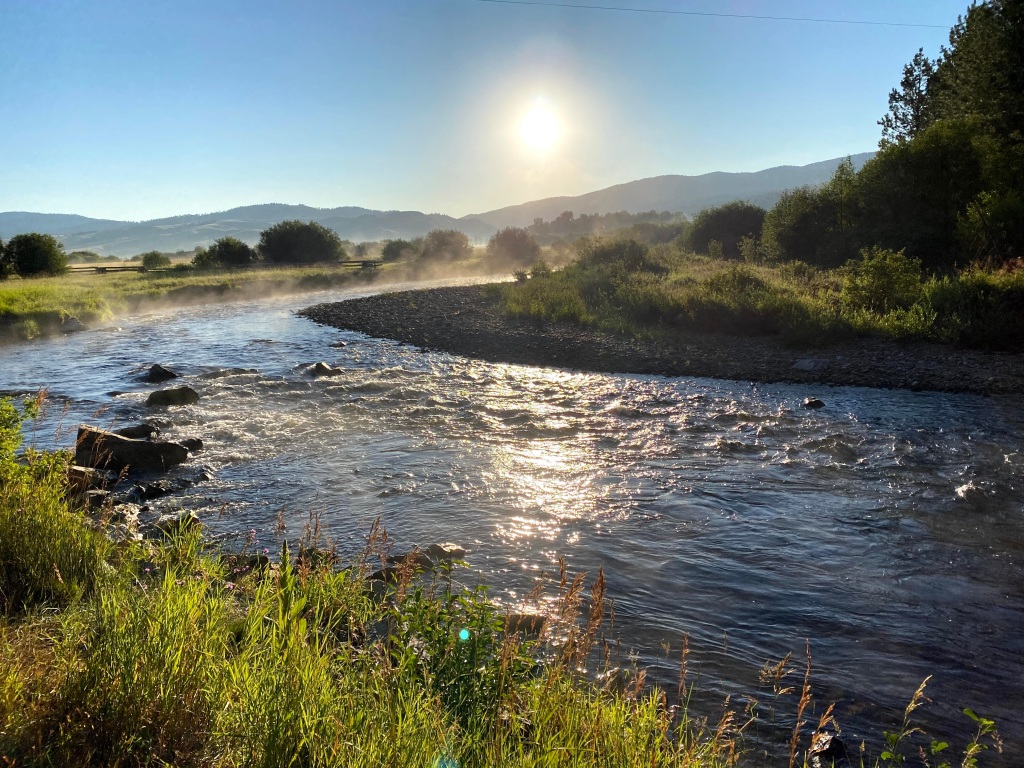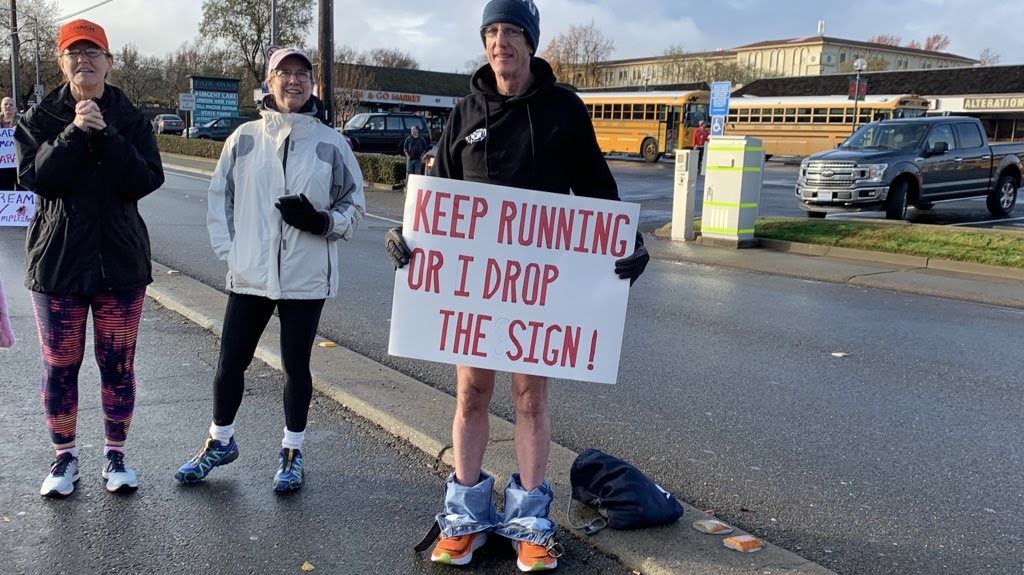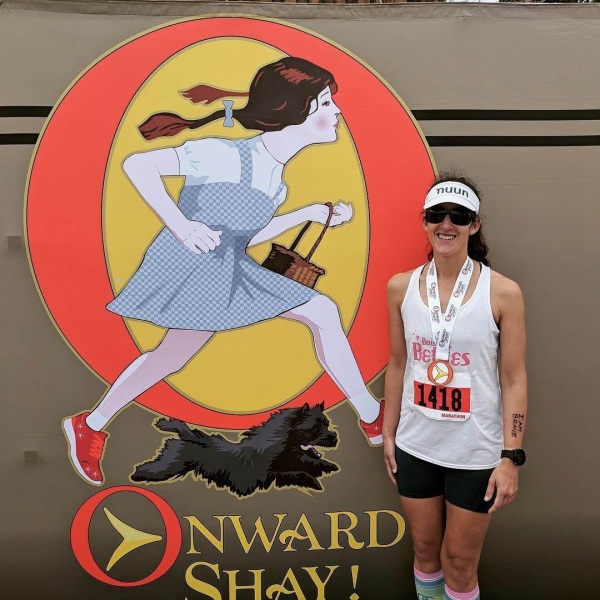“Be here now.” – Ram Dass
To keep people spread out due to COVID, the 2021 Boston Marathon start was a rolling start. Instead of bringing everyone out to the start line and starting all at once in a big mass, runners were bussed out to the start gradually over several hours and started whenever they got to the start line and felt ready to go. I personally liked the rolling start. It was nice because it was not overly crowded, and the port-a-potty lines were short. It was definitely a different vibe though without the excitement of a mass race start and the national anthem. It felt a bit strange just to walk to the start line and start your watch whenever you wanted like you were going on a Saturday long run.
After some final stretches and one last trip to the port-a-potty in Hopkinton, I walked up to that beautiful blue and yellow start line, pressed the start button on my Garmin, and started running. A few steps later I heard a volunteer shout, “You’re running the Boston Marathon! How cool!” I felt the tears well up in my eyes again. I could not believe this was happening. As I passed the mile one sign, I blew a kiss into the air and thought to myself, “I let go of expectations.” My plan for the race was “Be here now.” I knew it would be hard with warmer temperatures and a shorter training cycle, but I wanted to enjoy every moment. I had worked so hard to get to the start in Hopkinton and I wanted my run from Hopkinton to Boston to be a celebration.
I started my run around 10:30am. It was already 70 degrees with 80% humidity. By mile two I felt too hot. Slight panic started to creep up, but I came back to my race plan, “Be here now.” At the water stations, I started taking a couple of sips of water and dumping the rest of the cup on my head. I tried to keep my pace smooth and not get carried away by the early downhills. With long deep breaths, I tried to hold myself back because I knew I would need to conserve my energy for later in the race. One spectator was yelling at people to relax on the downhills. I felt like he was speaking to me personally, and it reminded me to let go of the tension I tend to hold in my upper body.
By mile nine, I felt tired. Too tired. I just noticed the feeling and told myself, “It’s ok to feel tired. This is hard.” Then I thought to myself, “You are running the fall Boston!” I did my best to ground myself in the present moment, observing the leaves and the beautiful fall colors reflecting in the nearby lake. Be here now. It is interesting to note that by doing this practice I seared that moment into my memory. I can still clearly remember the beautiful fall leaves on the ground and the humidity hovering above the water.
The Boston spectators and volunteers were phenomenal. After almost two years of no races, having the opportunity to run a large and well-supported race was electrifying. Many spectators shouted, “We missed you!” because there had not been an in-person Boston Marathon since April 2019. They had Halloween decorations, therapy dogs, trick or treat stations, otter pops, beer (I was very tempted by the Coors Light within grabbing distance at mile eight!), and anything else you could think of. I was wearing my Boise Betties singlet and every time someone would shout, “Boise Betties!” I would feel so much gratitude towards my Betties teammates and coach who helped me get to Boston.
Mentally, I had broken the race up into segments: Miles 1-10, 10-16, 16-21, and 21 to the finish. Although it felt hard early on, I focused my attention on breathing, relaxing and holding back a little bit, and noticing the beauty around me. I knew that there were some hills coming up later in the race in the 16-21 segment and I didn’t want to blow up prior to the hills! I would not allow myself to mentally calculate how many miles were left in the race. When my mind tried to go there I reminded it, “Be here now” and came back to the present moment.
As I approached Wellesley at the halfway point, I could hear the cheering from the scream tunnel of Wellesley College girls almost a half mile away. The high pitched roar sent chills up my spine. It was so fun to run through and high five some of the girls. I didn’t see anyone actually kissing this year, but many of the signs said “Blow me a kiss!” so I did lots of that!
After making it through Wellesley, I knew that the Newton hills would be coming up shortly. I tried to absorb the excited energy of the Wellesley girls and keep it in my back pocket for the Newton hills. Around mile 14 or 15 I saw some spectators with a “Go Go Idaho!” sign that looked like a play on the famous Citgo sign. I ran all the way to the other side of the road to give them some Idaho love, show them my Boise Betties singlet, and take a photo of their awesome sign.
As I entered Newton and approached the first big hill at mile 16, I tried to focus on running it by effort and not by pace. I was about to find out if I had relaxed and taken it easy enough on the downhill during the first several miles. In my mind, the first hill was the hardest. It was hot and the incline seemed long. I made it past that one and thought, “three more of these?!” However, I didn’t really notice the second or third hills because they were much shorter. The spectators helped carry me up and over the fourth hill (also known as Heartbreak Hill), and once I made it over Heartbreak Hill, I was done with the Newton hills!
I knew from studying the course map that Boston College was just after Heartbreak Hill around mile 21. This University of Virginia alumnae has never been more excited to see Boston College fans in her life! I made it past the hills and still felt OK! These last few miles were going to be amazing! There might be some suffering along the way, but if I stayed with the discomfort, there would be joy as well. I was big enough to hold both.
Up until this point, I had done a good job of fueling and hydrating. I had been taking water and/or Gatorade from every water stop and a gel every four miles. After mile 20, however, slight nausea started to creep in. I opted to skip the mile 23/24 gel, but was able to keep up on the water and electrolytes. Anyone who has run a marathon knows that the real part of the race starts after mile 20 and that anything can happen during that last 10k. I tried to stay focused and keep grinding – one step and one breath at a time. I said the sound of OM a few times and thought of my yoga family and perhaps others around the world who also might be saying the sound of OM. I connected with something larger than myself to propel myself forward.
When I passed the “Entering Boston” sign, I could again feel the tears. I couldn’t believe that I was running the Boston Marathon, made it into the city of Boston and hadn’t hit a wall yet. I started hearing people cheering “Go Danica!” and realized that I was running just behind NASCAR driver Danica Patrick. I saw the famous Citgo sign on the horizon. My family told me that they might come to cheer around mile 24 so I started looking for them which was a nice distraction. When I didn’t see them I figured they had found something more fun to do.
After I gave up on finding my family I realized that I was getting really close to making what I consider to be the most famous turns in running: Right on Hereford, Left on Boylston. I had imagined making these two turns in my head for years: while visualizing and preparing mentally for other races, while doing hard workouts, and while just daydreaming about what it might feel like to run the Boston Marathon.
What actually happened as I made the final turn and ran the last 600 yards or so down Boylston Street far exceeded anything I had imagined. I blew a kiss at the street sign at the corner of Hereford and Boylston. I made my way down Boylston Street feeling good and strong, shouting “F*&! Yeah!” (sorry to any kids that may have heard) and “Thank you, Boston!” The energy on that final stretch was absolutely phenomenal. I glanced at the sidelines about 400 yards from the finish and saw my husband and kids there cheering for me! (They were shouting “Hu! Hu! Hu!“) I crossed the Boston Marathon finish line with one hand over my heart to honor my inner child and the other hand extended upwards towards the sky in gratitude. We did it!
Going into the race I had an A, B and C goal. My A goal was 3:50, B goal was under four hours and C goal (which really was the most important one) was to have fun! I crossed the finish line in 3:51:07 and was absolutely ecstatic to have run the Boston Marathon in under four hours.
Every physical or mental setback, every tear, every workout or race where I imploded – it was all a part of this journey and it could not have happened any other way. No matter what that big, scary, seemingly unattainable thing is that you dream about, I am here to tell you that you can make it a reality. Write it down, be consistent, keep showing up for yourself, and when it’s time it will all unfold with beauty and magic.


























